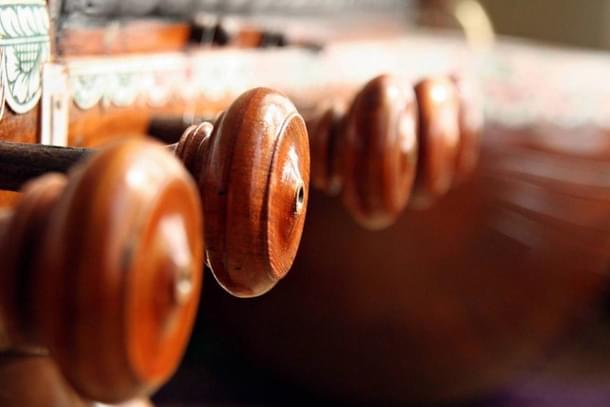Politics
Christian Appropriation Of Carnatic Music: Why Musicians Can’t Hide Behind The ‘Secular’ Hypothesis
Swami Venkataraman
Oct 03, 2018, 11:06 AM | Updated 10:56 AM IST
Save & read from anywhere!
Bookmark stories for easy access on any device or the Swarajya app.


The controversy over Carnatic musicians O S Arun, Nithyasree Mahadevan, Aruna Sairam and others performing at Christian events or releasing Christian-themed albums has now officially expanded beyond the community of musicians and its patrons.
Musician T M Krishna released a statement signed by 175 activists, almost all well known for their far-left political views, against “harassment and intimidation” of musicians and opposition to what he claims is the creation of a “modern syncretic tradition in Indian classical music”.
The most recent debate, however, has focused only on red herrings such as plagiarism, online abuse, and artists’ freedom of expression. And while issues related to cultural appropriation were raised, the discussions have lacked nuance and ended up portraying protestors as simply hate-mongers. The concerns of many rasikas of Carnatic music, including this writer, remain unarticulated.
As far as it can be seen, none of the Christian songs in question simply replace Jesus for Rama or Krishna. That would indeed be absurd and objectionable. So, mere plagiarism isn’t the real issue here. If anything, even many modern Hindu devotional songs are based entirely on older tunes. The misplaced focus on plagiarism allowed Krishna to hint at plagiarism on the part of saint Tyagaraja himself, based ridiculously on specific words that existed in older compositions, such as descriptive phrases used for deities or philosophic terminology. He also cited the use of well recognised Carnatic music concepts such as varnamettu (standardised melodies for ragas used for composing songs) as possible examples of ‘plagiarism’.
The Carnatic artists in question are generally devout Hindus and hardworking professionals. Abuse directed at them is unfair and only weakens the case many Carnatic rasikas seek to make. Neither can these artistes be denied the right to direct their musical talents in a direction of their choosing. One reason for angst among a section of rasikas is that more so than Hindustani music, Carnatic is heavily oriented towards bhakti and lyrical content, and the art form is dominated by saints like Purandaradasa, Tyagaraja, Annamacharya, Muthuswami Dikshitar etc. The music and the musicians are seen in effect as torch bearers of Hindu bhakti.
This is, perhaps, an unfair burden to place on musicians, but I suspect many of them recognise this sentiment among a plurality, likely a majority, of the niche audience for their music. If Carnatic music is to be seen as much Christian as Hindu, and that’s a big if, it requires a major cultural change. There are certainly no grounds to abuse musicians, but at the same time, “in your face” pronouncements to sing a new song on Jesus or Allah every month are not exactly the best way to win hearts and minds. Many musicians have been singing non-religious songs in movies for years now. And much as Christian-born music maestro K J Yesudas sings songs in praise of Hindu deities, others, including Krishna himself, have often included songs composed by eighteenth and nineteenth century Christians such as Vedanayagam Sastriyar or Abraham Pandithar without protest.
The upsurge of protests this time was, perhaps, likely driven by the growing awareness in recent years of institutional, missionary Christianity’s appropriation of Hindu concepts and contributions - including the classical art forms Bharatanatyam and Carnatic music. The spectacle of Hindu musicians seeming to collaborate in such efforts is really the key issue here. Appropriation is a term that should be understood carefully and in a limited sense. The Oxford Dictionary, which added the phrase “cultural appropriation” only last year, defines it as “the unacknowledged or inappropriate adoption of the customs, practices, ideas, etc. of one people or society by members of another and typically more dominant people or society.” In a globalised world, where there are no more pure cultures left, this definition can still be vague. Any expectation not to use products and ideas of other cultures would make daily life virtually impossible or unrecognisable. The key consideration therefore, in my view, is intent and mutual respect on the part of the borrower.
T M Krishna points out that Muthuswamy Dikshitar of the Carnatic trinity of composers famously composed songs in praise of Hindu gods based on Celtic/Scot band music played in the British cantonment near Dikshitar’s residence. While this is cultural borrowing or intermingling, it is not appropriation because Dikshitar was never a part of an organised effort to denigrate the cultures from which these melodies emerged. Neither did Dikshitar seek to convert Celtics to Hinduism and nor does any other Hindu who may play these songs. Such respectful interchange, which also forms the basis of fusion music, ought to be welcome and encouraged. On the contrary, missionary denigration of Hinduism and Hindu gods, who are the subject of Carnatic songs, and attempts at proselytisation of Hindus have a long history.
Rakesh Vaidyanathan, a friend and management consultant in the US, suggested as an analogy, the American tradition of jazz music or hip hop. They have deep roots in Black American culture and history, including their struggles against racism. Much as Carnatic music is used in cinema, these have emerged as major art forms, including a European jazz genre. But how would people react if sympathisers of the confederacy or Ku Klux Klan (KK) in the US or of Nazis in Europe were to use jazz or hip hop as the medium to propagate their message, under the cover of an artist’s freedom of expression. And what if black American musicians aided the KKK in this process? The point here is not to equate Christianity with the KKK. It is simply to point out malintent and the lack of mutual respect on the part of the borrower, whose primary ideologies can be hurtful to the tradition that is the source of the art form.
Many have pointed out that there have been notable instances over the past century of collaborations between prominent Carnatic musicians and Christians in creating music. Some of this could well be genuine sharing. However, a broader awareness of cultural appropriation, and its deleterious impact when not accompanied by genuine respect, has grown only in recent years. Such appropriation encompasses a whole gamut of other aspects of Hindu culture as well.
Missionaries are now claiming “Christian yoga” as a thing, seemingly ignorant that the word ‘yoga’ itself means the union of the individual self with the divine, a concept surely heretical to official Christianity. In a wicked twist of words, Surya Namaskar (sun salutations), now becomes ‘Son salutations’. This is very different from simply practising yogasanas as a physical exercise while acknowledging the Hindu roots of yoga. The latter is borrowing, the former is appropriation.
Appropriation often descends into outright deception, and has an old history. Robert de Nobili (1577 -1656) was a Jesuit who wore saffron robes, sported a sacred thread, and claimed to have discovered the manuscript of the “fifth Veda”, which showed Hinduism as a corrupted version of Christianity. It was praised by no less an intellectual than Voltaire, and not formally refuted until 1782. Nobili pioneered the use of the word Veda (Vedam in Tamil) to refer to the Bible, guru for Christian priests, and puja for a mass in church. Each of these terms means something entirely different within Hinduism, even if one could see superficial similarities. Such deceptions continue to this day in the southern districts of Tamil Nadu, which have a significant population of converts, including the term Veda-koil (Vedic temple) for a church and Veda-Agama schools for Christian theological schools.
There is a whole laundry list of such deceptions. There is Christ Bhagavatam, Yesu Suprabhatam, and Christu Sahasranamam using terminology that is unique to Hinduism, very confusing to the average listener and, in the case of the latter two, even using the same popular melodies as the Hindu mantras. In this context, it is important to add that sacred sounds found in the Hindu mantras and prayers themselves are considered to be conduits for spiritual experience and union with the divine, concepts that simply don’t exist in Christianity. There is the growing use of purely Hindu architectural elements such as a dwaja stambham (flag mast) in Christian churches in Tamil Nadu and Kerala. There is even an “Isavasya Upanishad” by a prolific fabricator called “Prof” M M Ninan playing on “Isa” as an Indian version of Jesus’ name and the fact that Isavasyam idam sarvam is the beginning of the Hindu Isha Upanishad. What genuine motivation could possibly exist for such malicious fabrications?
Bharatanatyam dance form has for some time also been a target like Carnatic music. This tradition, which finds basis in Natyashastra, Saiva Agamas, etc, and is also renowned as a vehicle of spiritual practice that culminate in self-realisation are now being developed as vehicles to propagate a “my way or hell” Christianity whose missionaries routinely misrepresent or denigrate Hinduism. One of the Christian personalities associated with the recent events is Jegath Gasper Raj, a Catholic priest who was director of the Tamil service of the Vatican controlled Radio Veritas, politically close to the Dravida Munnetra Kazhagam in Tamil Nadu, and who also served for years as an intermediary for the Liberation Tigers of Tamil Eelam militant group.
Everyone can claim noble intent, but given the global history of Christianity, Hindus are justified in being cautious, especially in their own people facilitating appropriation, even if unwittingly. After all, the Christmas tree, celebration of the winter solstice festival as Christmas, and the Easter Bunny from the festival of the fertility goddess are all that remain of the pre-Christian Pagan cultures of Europe. Hinduism has certainly survived numerous invasions and cultural onslaughts, but it did so precisely because its people endeavoured to protect and practise their culture, and borrow from others only in a true spirit of mutual respect and sharing.
As a keen Carnatic enthusiast and as someone married to a Carnatic musician, I believe that I have both the familiarity with the culture of the music fraternity, and a certain amount of personal capital, to make the following appeal to Carnatic musicians:
To all musicians who were abused or threatened by trolls, you deserve an unconditional apology for the same. At the same time, please understand that there are plenty, perhaps a majority, of rasikas who feel significant unease over the various forms of appropriation illustrated above as awareness about these spreads. Your collaborators are not well-wishers of Hinduism and often carry scant respect for Rama and Krishna. The Hindu acceptance of multiple paths to god should not imply disregard for the principle of mutual respect. Respect needs to be a two-way street.
And, no Mr Krishna, you are not allowed to claim that Carnatic music is “inherently secular”. It was, is, and shall forever be an intrinsic part of Hindu spiritual and devotional practice where its roots lie. Much like yogasanas alone are practised for physical benefits, Hindus can accept the use of Carnatic music for non-devotional renditions. But we will not remain mute spectators to your attempts at uprooting Carnatic music itself from Hinduism, and will reserve the right to disapprove the exploitation of Carnatic music to aid the undermining of the very tradition that created it.
Swami Venkataraman, an Executive Council member of the Hindu American Foundation, is a financial analyst based in New York. He holds an MBA in Finance from IIM Calcutta and a B.Tech in Electronics Engineering from IIT Madras.





